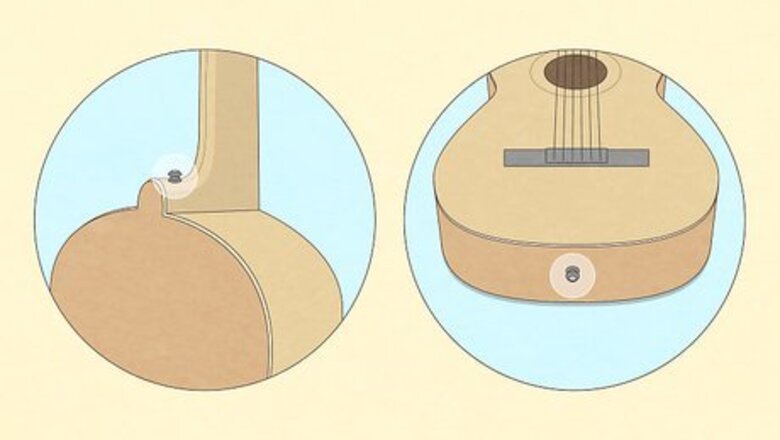
views
- Look for your guitar’s strap buttons, or metal studs, protruding from the very bottom of your guitar and at the top where the neck and body meet.
- Then, push the hole at one end of your strap over the bottom button. Slip the other hole on the strap over the top button, tugging on the strap to make sure it’s secure.
- If your guitar only has a bottom button, thread a string through the hole at the top of the strap and tie it under the strings towards the bottom of the headstock.
Attaching a Strap to Guitars with 2 Strap Buttons
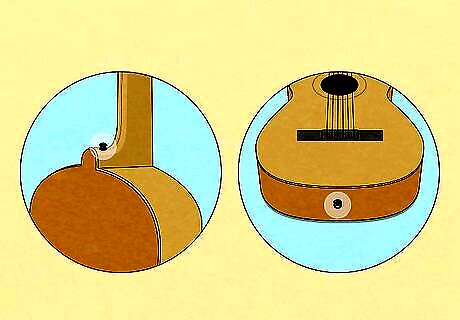
Look for the strap buttons at the top and bottom of the guitar's body. Most electric guitars have 2 strap buttons (also called pins) that look like small metal studs. The first button is usually located at the very bottom of the guitar, near the lower bout. The other button is typically at the top of the guitar, near where the neck and body meet. On some guitars, the top button is on the neck of the guitar, or the long, narrow section of the guitar that holds the frets, or strings. The strap buttons typically stick out about ½ inch (1.25 cm) from the guitar’s body. If your guitar doesn't have any buttons, install your own to use a strap. Some acoustic guitars may also have 2 strap buttons.
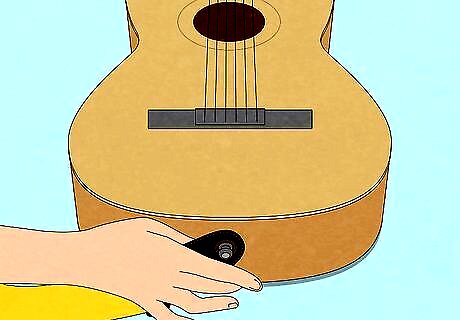
Slip one of the strap holes over the button on the bottom of the guitar. If one end of your guitar strap has an adjustable buckle, choose this end to attach to the bottom strap button. Then, simply press the hole at the end of the strap over the strap button. The strap holes are usually made to fit snugly over the button, so it can take a bit of effort to force the hole over the button. Guitar straps typically have leather (or fake leather) ends in the shape of rounded triangles. On each end is a small hole with a slit cut in the side of it. These holes support the weight of your guitar while you play. Slip the strap hole over the button so the adjustable buckle faces outwards. Otherwise, it may dig into you as you play.
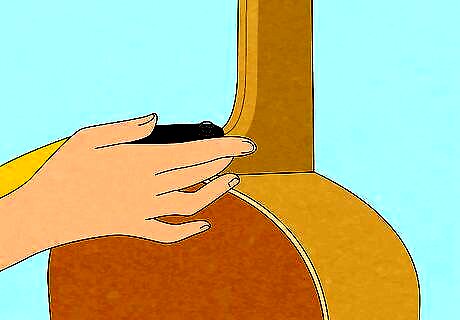
Push the other hole on the strap over the top strap button. Take the other end of the strap and pull it to the strap button near the neck of the guitar. Then, slip the strap hole over the button and push it down to secure the strap to your guitar.
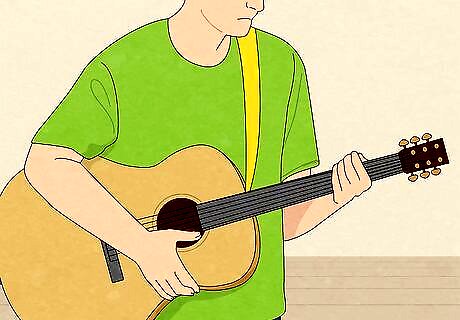
Test and sling on the strap to make sure it’s secure. Tug firmly on the strap to make sure it’s connected securely to both strap buttons. Then, sling the strap over the shoulder of your non-dominant hand. Play a few simple chords to ensure your strap fits comfortably and doesn't inhibit your movement in a variety of positions, like standing up, sitting down, and even kneeling or laying down. For example, if you’re right-handed, sling the strap over your left shoulder. The guitar hangs in front of you which allows you to strum with your right hand and fret with your left. If you are left-handed, place the strap over your right shoulder. If your strap easily slips off of the strap buttons, either get a new strap or install a strap lock.
Attaching a Strap to Guitars with 1 Strap Button
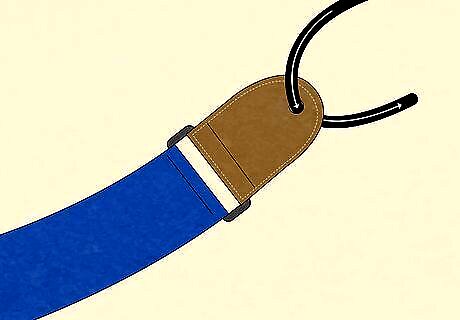
Loop a string or lace through one of the strap’s holes. Most acoustic and classic guitars only have 1 strap button located on the bottom of the guitar. To attach a strap with only 1 pin, you tie the other end of the strap to the headstock of the guitar. So, simply pull a piece of string or lace through the hole at either end of the strap. If your strap has an adjustable buckle, loop the lace through the end that is the farthest from the buckle. Some straps come with a string or thin strap of leather that is included for pulling through the strap hole. Alternatively, pull a strap adapter through the strap hole. This is a piece of fabric with a hole and button on either end that you wrap around the guitar’s headstock.
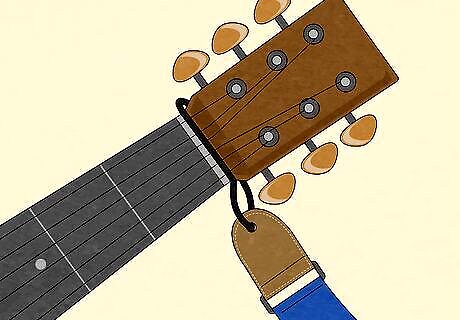
Tie the string to the headstock and under the strings. Pull the ends of the string up to the headstock of your guitar, which sits above the neck at the top of your guitar and houses the strings and tuning pegs. Then, loop the lace under the strings towards the bottom of the headstock, just above the top knut on the neck. Simply double-knot the lace to ensure it stays in place. Try different string placements to find one that feels the best to you. Tie the string around the entire headstock, or loop it around the section in the middle. Experiment with tying the knot loosely or tightly to see what feels comfortable to you. Do not tie the lace over the strings, as this can affect the tuning of your guitar. Tying the strap to the headstock can put pressure on the neck joint and damage the finish.

Slip the other strap hole over the button on the bottom of the guitar. Take the other end of the strap and pull it to the very bottom of the guitar’s body, near the lower bout. Look for the protruding strap button and then push the strap hole over it. If your guitar has an adjustable buckle, place this end at the bottom button.

Pull on the strap to ensure it’s secure, then sling it over your shoulders. Gently tug either end of the strap to ensure the string is tied tightly to the headstock and the hole is firmly over the bottom button. Then, slip on the strap over the shoulder of your non-dominant hand. Practice strumming a few notes or chords to make sure the strap and guitar feel comfortable while you’re standing up or sitting down. If you’re right-handed, slip the strap over your left shoulder. If you’re left-handed, place the strap over your right shoulder.
Adjusting the Guitar Strap
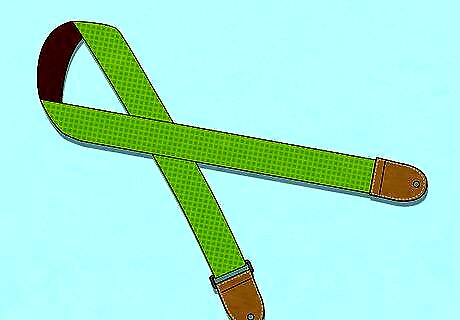
Find a guitar strap that fits you comfortably. Try on different guitar straps to find one that feels good and supports the weight of your guitar. Look for straps that are adjustable so you can make them long or short enough to reach the guitar when you stand up. Then, opt for a wide, padded strap so the material doesn't dig into your neck or shoulder as you play. The padding in the strap also affects its weight and how it sits on you. Foam padding tends to be more lightweight, while gel adds additional cushioning. Choose a strap material that fits your guitar and your style. Cotton straps are perfect for lighter guitars, while leather is super durable for heavier guitars. Guitar straps also come in a wide variety of styles and designs, so find one that speaks to you.
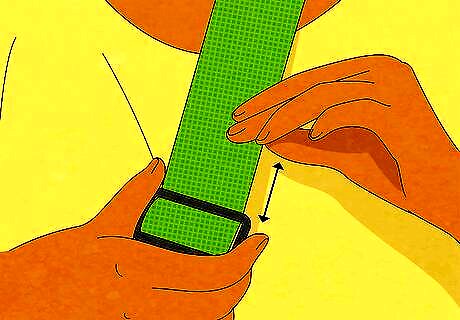
Slide the strap adjuster up and down if it has a buckle. When you play with a strap, adjust it so it hangs at a height that lets you strum and fret easily. If your strap has an adjustable buckle, pull it towards the bottom strap button to make it longer. Or, slide it towards the top strap button to make it shorter. Orient the strap so the buckle is near the bottom strap button and faces outward so it doesn't dig into your shoulder while you play. EXPERT TIP To adjust your guitar strap, pull one of the straps through the buckle until it's the length you want. Aaron Asghari Aaron Asghari Professional Guitarist & Instructor Aaron Asghari is a Professional Guitarist and the lead guitarist of The Ghost Next Door. He received his degree in Guitar Performance from the Guitar Institute of Technology program in Los Angeles. In addition to writing and performing with The Ghost Next Door, he founded Asghari Guitar Lessons, where he was the primary guitar instructor for many years. Aaron Asghari Aaron AsghariProfessional Guitarist & Instructor
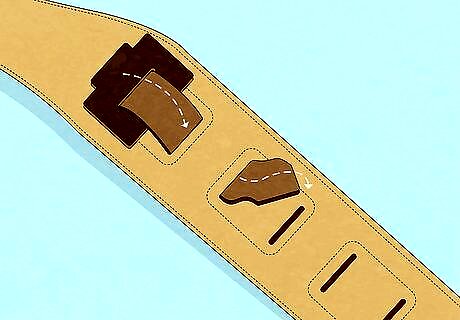
Pull the thin strap through a hole in the wide strap if there’s no buckle. Some guitar straps come in 2 pieces: one is long and wide with holes in it, while the other is thin with a pointed tip on one end and a flap with a slit on the other. Choose a hole and push the pointed tip of the thin strap through the back of the wide strap. Insert the thin strap through a hole next to it so the tip is under the wide strap. Then, pull the tip through the flap with the slit. The pointed tip has a hole that you push over the strap button. Just thread the tip of the thin strap through a hole at the end of the wide strap so it reaches the button. If the strap doesn’t feel comfortable because of the hole you chose, unloop the thin strap and choose a different hole to adjust the length.
Installing Guitar Strap Buttons
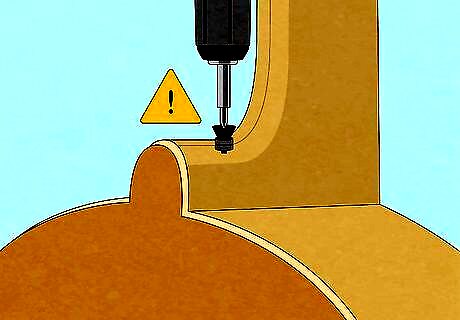
Understand the risks of installing your own strap buttons. If your guitar only has 1 strap button or none at all, putting in strap buttons is a great option to support your guitar. This involves drilling into your guitar, which can crack the wood and permanently damage it if you make a mistake. If you're inexperienced with modifying guitars, visit your local guitar shop and ask if they can install the buttons for you.
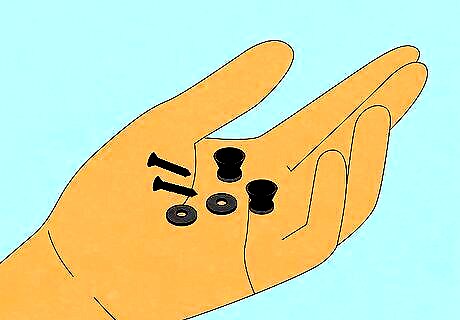
Find strap buttons and felt washers at your local music shop. Some strap button kits come with the washers included. However, in some cases, they are sold separately. The felt washers keep the buttons from wearing away the finish on your guitar, so make sure to get them if they don't come with the buttons. Strap buttons come in different finishes, colors, and designs, so look for a style that works with the finish and style of your guitar. Most strap button kits are sold in sets of 2. Depending on the style you choose, they are generally around $5-15 USD. For added security, use locking strap buttons. These are metal pieces that fit onto the strap so the strap doesn’t fall off while you're playing.
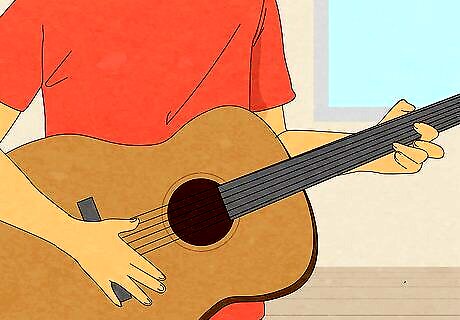
Hold your guitar as if you are playing it. Stand or sit the way you normally play, holding the guitar how it is most comfortable for you. Even when you use a strap, your hands support most of the weight of the guitar. So, holding the guitar normally helps you determine where the strap sits most comfortably. It's important that the strap feels comfortable. Otherwise, wearing it can interfere with your playing.
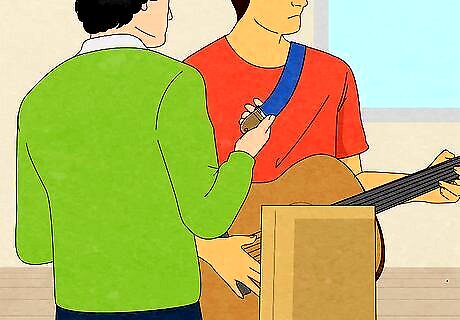
Get someone to drape the strap around your neck. To stay in your comfortable position, ask a friend or family member to rest the strap across the shoulder of your non-dominant hand. Then, drape the ends of the strap down so they reach the bottom and top of the guitar’s body. Pull the end of the strap that attaches to the top of the guitar in front of your left shoulder (if you’re right-handed), and wrap the end that attaches to the bottom behind your right shoulder. If your strap has a cushion, make sure that portion is on top of your shoulder. The button at the top of the guitar’s body is typically where the neck and body meet. If your guitar already has a strap button on the bottom of the guitar, go ahead and push the strap hole over the button. Then, wrap the strap behind your back and over your opposite shoulder to the top of the guitar’s body.
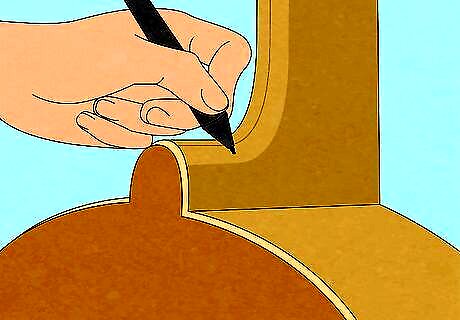
Draw a mark on the guitar where you want the buttons to go. Place each mark at least 1 ⁄4 in (3.2 cm) in from the edge of the guitar. Make the first mark at the bottom of the guitar and towards the middle seam, or at the point closest to the floor when you stand your guitar up. Then, place the other mark at the thickest point where the body and neck connect on the side of the guitar that’s furthest from your chest. Make the marks as small as possible so the buttons cover them. It’s possible to crack the wood when you install a button where the neck and body meet. If you don't want to take this chance, use a string to tie the strap into place.
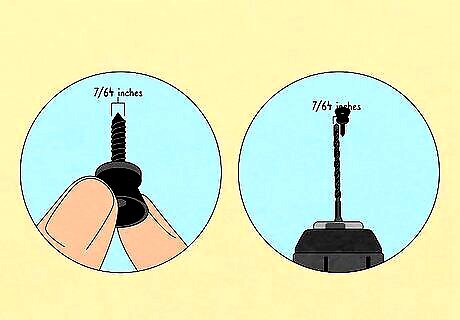
Measure the screws and select a drill bit that's slightly smaller. Take a ruler or measuring tape and measure the screws that came with your buttons. Then, put a drill bit onto your drill that’s slightly smaller than the width of the screw. If the drill bit is exactly the same size as the screw, the screw might strip out the wood and not hold the strap securely. The size of the strap screws may vary by manufacturer, so measure them even if you've done this before. For example, if the diameter of your screw, including the threads, is ⁄64 in (0.36 cm), but the diameter of the shaft without the threads is ⁄64 in (0.28 cm), use a ⁄64 in (0.28 cm) drill bit.
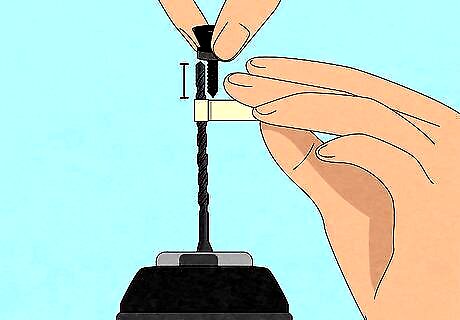
Mark the length of the screw on the drill bit with tape or a marker. Screwing too shallow or deep into the guitar can crack the wood. So, hold up the strap button screw to the drill bit you’re using. Then, mark the end of the screw on the drill bit with tape or a marker. This ensures that you’ll drill only as deep as the screw. The depth varies depending on your guitar and the location of the hole, but it’s typically no more than ⁄2–1 in (1.3–2.5 cm).
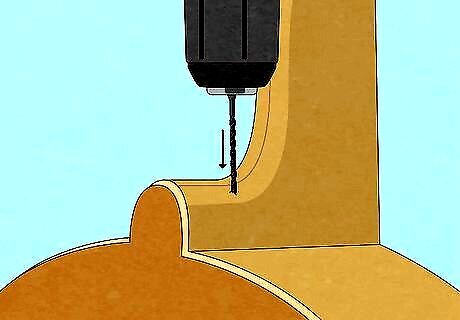
Drill the hole, then countersink it with a Phillips-head screwdriver. Lay the guitar flat on its back or prop it up on its side. Then, place your drill directly over the button mark and slowly drill into the wood. Stop when the tape or marker line touches the guitar and slowly reverse the drill out. Next, insert a Phillips-head screwdriver into the hole and rotate it a few times. Countersinking the hole helps create threads that ease your screw inside the hole. If you have a countersink tool, use that instead. Countersinking also helps prevent the wood from splitting or the finish from chipping.

Twist a felt washer on the screw and screw the button into the hole. Insert the screw through a felt washer. Then, set the screw over the hole. Using a Phillips-head screwdriver, carefully screw the button inside the hole. Just stop twisting once the screw feels snug and tight. If your strap buttons didn’t come with felt washers, buy them separately. Or, cut out a small square of felt and screw the button screw through it. The felt washer keeps the strap button from rubbing against the finish on the guitar, which can dull or damage it. If the button seems like it’s going in at an angle or it’s stuck, stop what you’re doing and unscrew the button. Otherwise, you might crack or split the wood.
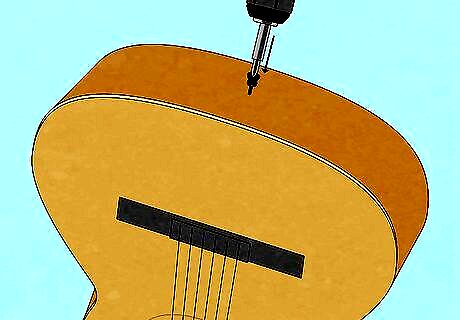
Repeat the process for the other strap button. If you're installing 2 buttons, drill and countersink the hole at the other mark you made. Add the felt washer to the other button, then screw it into the hole. If you're only installing 1 button, then you're finished!
Using Strap Locks
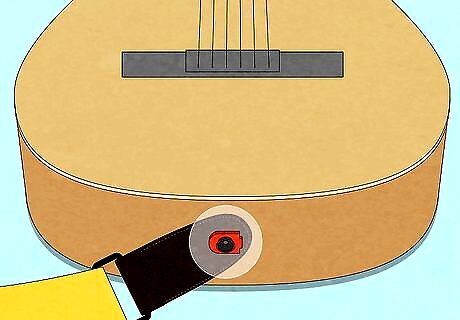
Place a plastic or rubber lock over the strap and the button, then twist. Strap locks are handy tools that keep your strap from slipping off of the buttons while you’re playing. Basic strap locks are plastic or rubber discs with holes in the middle and a set of ridges on a rotating upper portion. To install one, just push the hole through the strap button and on top of your strap. Then, use the ridges to twist the lock into place. Installing a strap lock on top of the strap at each button helps your strap remain in place no matter how much you twist or pull it while playing. You do not need to install special buttons for these locks. These are used over your existing strap buttons. Rubber can damage some guitar finishes, like those with a nitro-finish, so use plastic strap locks instead.
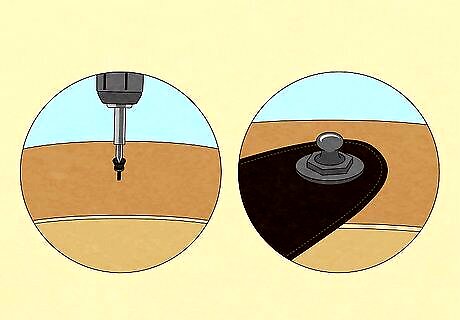
Screw in the strap lock if you’re using one made out of metal. Metal strap locks come in 2 pieces—one that you screw into your guitar that replaces the existing strap button, and one that attaches to the hole at the end of the strap. Just unscrew the strap buttons on your guitar and screw in the strap locks according to the manufacturer’s instructions. Then, follow the kit’s instructions for attaching the other piece to the ends of your strap. For most metal strap locks, the piece on the strap snaps onto the new strap button. To remove your strap, you just press the quick-release button which is usually on the side of the lock. Metal strap locks typically offer more security than plastic or rubber locks, which makes them a good option if you have an expensive guitar or you tend to move around a lot while you're playing.

Use ⁄16 in (0.79 cm) rubber washers if you don't have regular locks. While strap locks are generally fairly cheap, there are DIY alternatives. Tight-fitting rubber washer or seals that you can find on beer bottles and other household items fit snugly over your guitar strap and button. Like regular strap locks, rubber washers hold the strap in place while you play, making it more difficult for the strap to fall off your guitar. You can find rubber washers at your local hardware store.




















Comments
0 comment